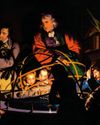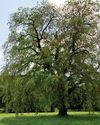
IT has to be one of the most terrifying moments in children's literature, a scene more suited to the extremes of Grand - Guignol than the cosy warmth of a bed-time story. When naughty Tom Kitten, in Beatrix Potter's The Tale of Samuel Whiskers, gets lost up the chimney, he falls into a small, 'stuffy, fusty' room, where he's bound up with string, to be turned into a 'kitten dumpling roly-poly pudding' by Mr and Mrs Samuel Whiskers, two vast rats. The greedy rodents argue as to the best recipe (Mr W insists breadcrumbs are essential), before stealing the ingredients from the kitchen, together with a rolling pin, smearing the terrified kitten in butter, then encasing him in dough.
The accompanying illustration, of a terrified Tom-just his head and tail peeping out as the rats get to work-haunted my childhood. His bacon is saved by John Joiner the terrier and the pudding doesn't go to waste either it's boiled in a cloth, 'with currants in it to hide the smuts-but never has a much-loved dish seemed quite as sinister. And it put me off roly-poly for life. Which is a shame, because roly-poly is one of the stars of the British pudding constellation, itself a rare culinary art for which we are renowned the world over. 'Blessed be he that invented pudding, cried M. Misson, a jovial Frenchman, towards the end of the 17th century, 'for it is a manna that hits the palates of all sorts of people; a manna, better than that of the wilderness, because the people are never weary of it!' The food writer and polemicist P. Morton Shand was equally enamoured. 'As a nation we are rightly proud of our puddings,' he thundered, and are inclined to sneer at the French for the dearth of their achievements and the poverty of their invention in this sphere. For once, perhaps, our exultation and self-satisfaction are justified.'
هذه القصة مأخوذة من طبعة February 15, 2023 من Country Life UK.
ابدأ النسخة التجريبية المجانية من Magzter GOLD لمدة 7 أيام للوصول إلى آلاف القصص المتميزة المنسقة وأكثر من 9,000 مجلة وصحيفة.
بالفعل مشترك ? تسجيل الدخول
هذه القصة مأخوذة من طبعة February 15, 2023 من Country Life UK.
ابدأ النسخة التجريبية المجانية من Magzter GOLD لمدة 7 أيام للوصول إلى آلاف القصص المتميزة المنسقة وأكثر من 9,000 مجلة وصحيفة.
بالفعل مشترك? تسجيل الدخول

A leap in the dark
The primal play of light and shadow, whether in Leonardo's ever-so-subtle sfumato or Caravaggio's dramatic contrasts, has shaped Western art, as Michael Hall reveals

Beauty and the blimp
Inflammable airships may be gone, but a new hybrid aircraft, capable of delivering eco-friendly aviation, is set to take to the skies with a bang, finds Charles Harris

Three wishes for food and farming
Royal hedge planting, the terrible toll on Ukrainian farming and a maiden speech

Seeing the wood for the trees
Scotland's much-evolved forestry industry has become a focus for clever investors

Let's fall in love
Birds do it, bees do it, even educated fleas do it. Laura Parker finds that, when it comes to creatures mating for life, persistence, patience and a little dad dancing are key to success

Back from the dead
THREE Wentworth elm saplings have been planted in the grounds of the Palace of Holyroodhouse, Edinburgh, and on the Highgrove estate in Gloucestershire-29 years after what was thought to be the lastknown Wentworth elm died.

A man among men
What makes a master? Beloved of the commercial art world, handled warily by art historians, the word has long been opaque. Michael Prodger investigates its many meanings-and discovers that being male confers an unfair advantage

Unearth one of life's luxuries
Black diamonds are a girl's best friend this Valentine's Day, with Périgord truffle-based skincare from TRUFFE

Adventure awaits
Spend an unforgettable family holiday on the Benmore Estate and experience some of Scotland's finest wildlife and sporting activities

Let the art rule the head
Despite being a world leader in everything from jewellery to fashion and music, the UK is failing to nurture creativity at school and in regional centres. Tristram Hunt, director of the V&A Museum, calls for an urgent review